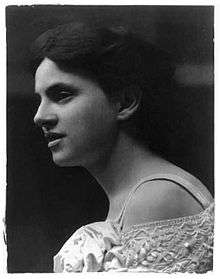Abastenia St. Leger Eberle
| Abastenia St. Leger Eberle | |
|---|---|
 | |
| Born |
April 6, 1878 Webster City, Iowa, United States |
| Died |
February 26, 1942 (aged 63) New York City |
| Nationality | American |
| Known for | Sculpture |
| Notable work |
Girl Skating (1907) White Slave (1913) |
| Movement |
Ashcan School New Sculpture Realism |
Abastenia St. Leger Eberle (April 6, 1878 – February 26, 1942)[1] was an American sculptor. Her most famous piece The White Slave representing child prostitution caused controversy when exhibited at the 1913 Armory Show.[2]
Early life
A native of Webster City, Iowa, her father was a doctor and her mother a musician. Her family later moved to Kansas, then Missouri, before settling in Canton, Ohio. She initially studied to become a professional musician, but her father noticed her talent for modeling. She received lessons from one of his patients before enrolling at the Art Students League in New York.
Early career
She achieved early success with her sculpture Men and Bull, created in collaboration with Anna Hyatt, which was shown at the 1904 exhibition of the Society of American Artists. In 1906 she was elected to the National Sculpture Society.[3] In 1920, she was elected into the National Academy of Design as an Associate Academician.
St. Leger Eberle worked in a style related to Art Nouveau and the New Sculpture movement. She produced mainly portrait sculpture and decorative work for fountains. Some of her work is in the collection of the Metropolitan Museum of Art. However, she is best known for figurative works that combined realism with emphasis on the flow of drapery and movement.
Later career

The White Slave was exhibited at the 1913 Armory Show in New York, and caused "a storm of violent controversy" because of its shocking combination of contemporary realism and the nude. The sculpture represented child prostitution, which at the time was euphemistically called white slavery.[3]
Following this success she created a number of sculptures depicting working class children from the Lower East Side, depicting them at play and work. These represented "the vitality of the city's immigrant population". By 1930 she had been forced to leave New York because of financial and health problems. She settled in Westport, Connecticut.[3]
Eberle submitted works to the mixed sculpturing category of the art competitions at the 1928 and 1932 Summer Olympics, but did not win a medal.[1] Several of her sculptures are on display at the Kendall Young Library, in Webster City, Iowa, where she was born. Eberle believed that art should have a social function, writing that artists "had no right to work as an individualist with no responsibility to others. [Artists] must see for people—reveal them to themselves and each other."[3]
Exhibitions
"White Slave"
- Armory Show, A Turning Point, 1913 NYC
- Knoxville Museum of Art, American Women Artists: The 20th Century, Oct. 26, 1989–Feb. 4, 1990
- Queensboro Community College Art Gallery. March 11, 1990–Apr.5, 1990
- Parrish Art Museum, Southampton, NY Feb. 20, 1994–Apr. 10, 1994
- Los Angeles County Museum of Art, Figure in American Sculpture, Feb. 23, 1995 – May 14, 1995
- Montgomery Museum of Fine Arts, June 22, 1995–Sept. 10, 1995
- Wichita Art Museum, Oct. 19, 1995–Jan. 7, 1996
- National Academy of Design, Feb. 15, 1996 – May 5, 1996
- The Discovery Museum, Bridgeport, CT, They Earned Their Keep The Struggles and Successes of American Women Artists, Apr. 10, 1993 – May 30, 1993
- Whitney Museum of American Art, NYC: Part 1: The American Century Art and Culture, 1900–2000, Apr. 23, 1999–Aug. 22, 1999
- Museum of Sex, NYC Inaugural Exhibit: New York City Sex: How NY Transformed Sex in America, Sept. 2–Feb.15, 2004 Curator, Grady T. Turner,
References
- 1 2 Gjerde, Arild; Jeroen Heijmans; Bill Mallon; Hilary Evans (July 2013). "Abastenia St. Leger Eberle Bio, Stats, and Results". Olympics. Sports Reference.com. Retrieved 2013-07-25.
- ↑ Susan P. Casteras, "Abastenia St. Leger Eberle's Whits Slave", Woman's Art Journal, 1986 (Jstor.org)]
- 1 2 3 4 Susan Casteras, Abastenia St. Leger Eberle's White Slave.", Woman's Art Journal (Spring/Summer 1986) pp. 32–36.
Bibliography
- Knoxville Museum of Art: “The 20th Century” Publisher, Elsa Honig Fine
- Abastenia St. Leger Eberle, 1980 Des Moines Art Center, Author, Louise R. Noun
- American Century, “Art & Culture 1900–1950 Author Barbara Haskell
- Visualizing Labor in American Sculpture, Author, Melissa Dabakis, Monuments, Manliness, and the Work Ethic, 1880–1935, published 1999
- Jane Scoular, 'The Subject of Prostitution: sex/work and social theory', Routledge 2009
External links
- Columbia Encyclopedia entry
- The East side in sculpture by Abastenia St. L. Eberle, an exhibition catalog available as a full-text PDF
- Official Catalogue of the Department of Fine Arts, Panama-Pacific, 1915